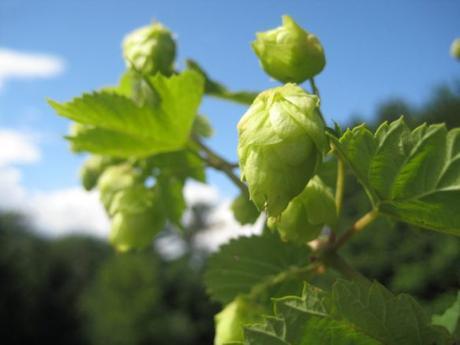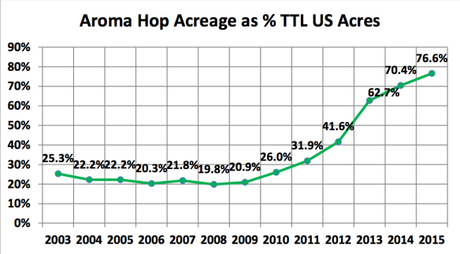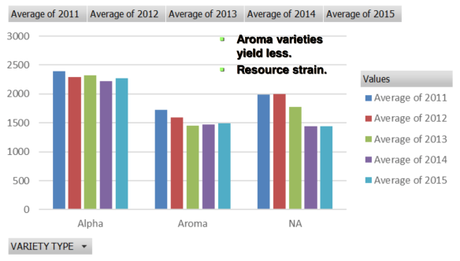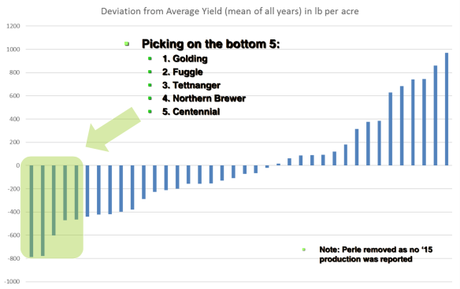
When it comes to hops, the well-known elephant in the room is the prominence now taken up by aroma varieties, which aren't just driving high ratings on Beer Advocate or RateBeer, but also the presence on farms across the country. Over the last decade, the shift from alpha to aroma varieties has been stark.

The change has been illustrated in several ways.
From its annual hop report, the Brewers Association collects the most heavily-used varieties by craft brewers. The lists from 2007 to 2015 are certainly different:
There is actually one less specific aroma variety on that 2015 list than 2007, but the increase in dual purpose hops is stark, especially when you consider how most brewers are using something like Simcoe or Centennial and the flavors they're extracting.
Spoiler alert: it's heavy on the late addition side to emphasize their unique fruity/juicy characteristics:
So what does this mean in terms of what - and how - varieties are being grown? More important, how can these changes be done efficiently when space is at a premium?
Our expectations as drinkers have quickly changed in the past decade and brewers have responded in kind, making regular adjustments to the IPA, America's favorite craft beer, to step further away from the bitter concoctions of the past. That's clearly influenced how hop producers are doing their jobs, too.
People up and down the supply chain love aroma hops, but if an issue the industry faces relates to space available and the overall yield of hops, a continued focus on aroma varieties across the board presents a unique challenge. During a presentation at this year's Craft Brewers Conference, Jason Perrault of Perrault Farms, Inc. pointed out the contrast in yields between alpha and aroma varieties.

He even went a step further, showing how a handful of varieties stack up when compared to the average amount of pounds per acre.

Which raises the question: how could producers adjust to better reflect the need for hops, especially with an eye toward increasing production levels to fulfill demand for the craft beer industry?
For example, here's the breakdown of the acres harvested and pounds yielded for Mt. Hood, Willamette and Fuggle from 2015:
If we use the threshold yield of 1,800 pounds per acre, a figure suggested as an ideal return rate, all these varieties fall well below. Together their 1,862 combined acres is minimal to what's planted across the U.S., but could potentially be made more efficient with another hop choice. Dual-purpose Loral, a newly released - but private - variety that has expected yields around 2,000 pounds per acre.
(There are many other factors to consider here, like brewer use, flavor preference and most important, the time needed to plant and grow a hop like Loral to maturation. There's also the fee that would need to be paid to access Loral.)Another example may be Magnum, which has a profile not far off from Warrior, but offered a yield below 1,800 pounds per acre in 2015:
Warrior, its latest figures from 2014, yielded 1,821 pounds per acre.
There are also cases like Mosaic, Columbus/Tomahawk/Zeus, El Dorado, Crystal and Apollo, all of which saw yields above 2,000 pounds per acre in 2015. Comet, now coming back into style after a hiatus, saw a yield of 1,780 pounds per acre in limited use in 2015.
Fluctuation is obviously something to consider, but by increasing the acreage diversity across hop production, two things happen: first, current acreage becomes more efficient, then extra space is opened up for additional varieties.

If Loral were to replace Fuggle and double that yield without any additional investment in infrastructure, a farmer could potentially open up some acreage to try a new hop or fill in with another variety preferred by brewers and drinkers at that time. Options abound.
Welcome to "Hop Week," an opportunity to look into how the production of hops impacts the beer industry, agriculture and drinkers.But even if all these changes were to be made in order to better assist the craft beer industry with the raw ingredients needed to hit its 20/20 goal, there is still another way to help address America's' insatiable love for hops. But is it too different to appease beer lovers?
Bryan Roth
"Don't drink to get drunk. Drink to enjoy life." - Jack Kerouac

